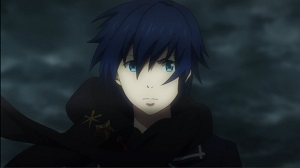written by Laurie Tom
 Gunslinger Stratos is the rare show I decided to watch despite having low expectations of it. It’s based off an arcade game only released in Japan, and because of being an arcade game, I was not expecting much of a plot. Mostly, I wanted to watch it because it had an interesting concept involving parallel timelines and the potential for really cool anti-gravity gunslinging combat scenes.
Gunslinger Stratos is the rare show I decided to watch despite having low expectations of it. It’s based off an arcade game only released in Japan, and because of being an arcade game, I was not expecting much of a plot. Mostly, I wanted to watch it because it had an interesting concept involving parallel timelines and the potential for really cool anti-gravity gunslinging combat scenes.
Unfortunately, Gunslinger Stratos largely fails to exploit either of those, which is a pity because it could have been a really cool action show.
Tohru Kazasumi is a typical unassuming “nice guy” anime protagonist in high school with a girl, Kyouka Katagiri, who likes him, but they aren’t dating (yet). They’re just friends.
In the 22nd century they live in, the world is tightly controlled by the government and due to a war some decades ago, Japan no longer exists, but outwardly the place they live in looks fairly advanced and on the surface, even utopian, with lots of greenery among all the beautiful white buildings.
Contrast that to a different timeline, where the people in the 22nd century live among rubble, scraping to survive, and the world has never recovered. In this world, Tohru Kazasumi has never gone to school, and he and Kyouka Katagiri have formed a family consisting of them and other orphaned children who work together to make sure there is enough food and clothing to make it to another day.
The two timelines clash when the mysterious Timekeepers intervene and ask both timelines to play a deadly game against one another in order to stop a phenomenon that is causing people around the world to mysteriously disintegrate into sand. Winning teams receive rewards that vastly improve their technology, making them stronger for the next round.
For some reason, this involves sending both teams back in time to a phantom 21st century where they battle one another using energy weapons provided by the Timekeepers and the combatants fly around in with anti-gravity assists, which have the potentially to be visually amazing (as they are in the Tohru vs. Tohru fight in the opening credits). Unfortunately the show itself never reaches that level of excellence.
The story works best when the characters consider what it’s like facing themselves (is it murder when they killed their counterpart?) and when we, the audience, see how the characters have turned out differently due to their environments.
But there’s not nearly enough of that. Most of the story is focused from the point of view of the timeline that recovered from the war, so it’s harder to get a feel for what it’s like for the team living in Frontier S (the harsher timeline), barring a single episode when main timeline Tohru crosses over. It’s too bad because that’s a missed opportunity to build more sympathy for the other side.
Also, quite frankly Frontier S Tohru is more interesting than main Tohru because he’s more willing to do whatever it takes to get a job done due to the losses he’s experienced. Main Tohru goes through a lot more questioning and angst that has been done before in other shows, but even when he loses teammates it doesn’t feel as strong as it does for Frontier S Tohru, because we know the latter has changed because of it.
Related to losses, there are a surprising number of characters who bite the big one over the course of the show, but most of them fail to matter for the audience. In some cases we might have seen them for all of five minutes before they die, but clearly they are someone due to their unique character designs.
I suspect this is a case of trying to shoehorn in all the playable characters from the arcade game, but someone who has never played the game would probably need a wiki to identify them all.
Even the lack of character development would have been all right if the imaginative fight scenes had been there, but after the early establishing episodes, the story attempts to move into a deeper plot and spends too much time on the true purpose of the Timekeepers and a strange detour with a secondary villain that didn’t need to happen.
There’s a lot of talk about changing the future while a particular future is trying to enforce, if not accelerate its existence, but the dialogue drowns it in a lot of pseudo-tech talk. By the end of it, I was pretty sure that if the Timekeepers had never intervened, they would have gotten the best outcome for their cause, but then we would not have had a reason for the story to happen in the first place.
Gunslinger Stratos has some nice ideas, but in the end I can’t really recommend it.
Number of Episodes: 12
Pluses: interesting concept, surprisingly sweet epilogue sequence, memorable J-pop themes for opening and ending credits
Minuses: shallow character development, nonsensical storyline, doesn’t live up to potential
Gunslinger Stratos is currently streaming at Crunchyroll and is available subtitled.

Laurie Tom is a fantasy and science fiction writer based in southern California. Since she was a kid she has considered books, video games, and anime in roughly equal portions to be her primary source of entertainment. Laurie is a previous grand prize winner of Writers of the Future and since then her work has been published in Galaxy’s Edge, Strange Horizons, and Crossed Genres.
